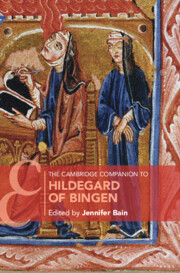Book contents
- The Cambridge Companion to Hildegard of Bingen
- The Cambridge Companion to Hildegard of Bingen
- Copyright page
- Dedication
- Contents
- Figures
- Tables
- Music Examples
- Contributors
- Acknowledgments
- Introduction
- Part I Life and Monastic Context
- Part II Writings and Reputation
- Chapter 4 Hildegard of Bingen’s Theology
- Chapter 5 Reading Hildegard of Bingen’s Letters
- Chapter 6 From the Roots to the Branches: Greenness in the Preaching of Hildegard of Bingen and the Patriarchs
- Chapter 7 Hildegard of Bingen: Illness and Healing
- Chapter 8 The Pentachronon and Hildegard of Bingen’s Reputation As a Prophet
- Chapter 9 The Context and Reception of Hildegard of Bingen’s Visions
- Part III Music, Manuscripts, Illuminations, and Scribes
- Select Bibliography
- Index
- Cambridge Companions To …
- References
Chapter 6 - From the Roots to the Branches: Greenness in the Preaching of Hildegard of Bingen and the Patriarchs
from Part II - Writings and Reputation
Published online by Cambridge University Press: 28 October 2021
- The Cambridge Companion to Hildegard of Bingen
- The Cambridge Companion to Hildegard of Bingen
- Copyright page
- Dedication
- Contents
- Figures
- Tables
- Music Examples
- Contributors
- Acknowledgments
- Introduction
- Part I Life and Monastic Context
- Part II Writings and Reputation
- Chapter 4 Hildegard of Bingen’s Theology
- Chapter 5 Reading Hildegard of Bingen’s Letters
- Chapter 6 From the Roots to the Branches: Greenness in the Preaching of Hildegard of Bingen and the Patriarchs
- Chapter 7 Hildegard of Bingen: Illness and Healing
- Chapter 8 The Pentachronon and Hildegard of Bingen’s Reputation As a Prophet
- Chapter 9 The Context and Reception of Hildegard of Bingen’s Visions
- Part III Music, Manuscripts, Illuminations, and Scribes
- Select Bibliography
- Index
- Cambridge Companions To …
- References
Summary
The significance of viriditas (greenness) in Hildegard of Bingen’s writing is well known, but how original was her thinking, and how important was it to her concept of preaching? This chapter surveys Hildegard’s activity as a preacher before broadly probing the content of her writing for signs of her adaptation of patristic models. Comparing Hildegard’s use of viriditas to the works of Sts. Ambrose, Augustine, and Gregory shows her following their inspiration, but she is seldom derivative. Rather, her exegesis and homiletics rely on a method akin to the intratextual hermeneutics on view in her Exposition of the Gospels. Like the church fathers, she uses her knowledge about natural science to convey a spiritual understanding of scripture, but her exegetic method is more dramatic and visionary as she explains the unifying forces of greenness. Borrowing salient concepts, words, and phrases from her models, she teaches her reader about the opposition of greenness and dryness as well as the relevance of internal and mental greenness to preaching and to prove that God’s greenness is manifest in her community of nuns.
- Type
- Chapter
- Information
- The Cambridge Companion to Hildegard of Bingen , pp. 125 - 143Publisher: Cambridge University PressPrint publication year: 2021



